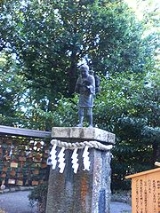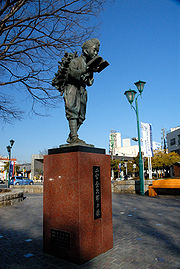
Ninomiya Sontoku
Encyclopedia

Economist
An economist is a professional in the social science discipline of economics. The individual may also study, develop, and apply theories and concepts from economics and write about economic policy...
.
Life
Ninomiya Sontoku was born to a poor peasant family with a name of Kinjiro in Kayama (栢山) AshigarakamiAshigarakami District, Kanagawa
is an administrative district of Japan located in western Kanagawa Prefecture. Most of the mountainous district is sparsely populated, and is part of the Tanzawa-Ōyama Quasi-National Park.-History:...
-gun
Districts of Japan
The was most recently used as an administrative unit in Japan between 1878 and 1921 and is roughly equivalent to the county of the United States, ranking at the level below prefecture and above city, town or village. As of 2008, cities belong directly to prefectures and are independent from...
Sagami province
Sagami Province
was an old province in the area that is today the central and western Kanagawa prefecture. It was sometimes called . Sagami bordered on Izu, Musashi, Suruga provinces; and had access to the Pacific Ocean through Sagami Bay...
. His father died when he was 14 and his mother died two years later. He was then placed in his uncle's household. While working in his uncle's land, Sontoku studied on his own. He later obtained abandoned land on his own and transformed it into agricultural land, eventually restoring his household on his own at the age of 20 and achieved considerable wealth as a landlord while in his 20s. He was then recruited to run his small feudal district which was facing considerable financial difficulty. He achieved this by reviving local economy, particularly through agricultural development. The daimyo, hearing of his achievement, eventually recruited Sontoku to run Odawara Domain
Odawara Domain
was a Japanese domain of the Edo period, located in western Sagami Province. It was centered on Odawara Castle in what is now the city of Odawara.-History:...
then Shimotsuke Province
Shimotsuke Province
is an old province of Japan in the area of Tochigi Prefecture in the Kanto region. It was sometimes called or .The ancient capital of the province was near the city of Tochigi, but in feudal times the main center of the province was near the modern capital, Utsunomiya.-History:Different parts of...
. He was eventually entrusted with one of Shogunate's estate, which was great honour for someone of his low origin. His philosophy and methodology became a standard format in feudal land, developmental and economic management. The name "Sontoku" was given to him for his accomplishments. After his death, the emperor awarded him with Jyu Yoni, Lower Fourth Honour under the ritsuryō
Ritsuryo
is the historical law system based on the philosophies of Confucianism and Chinese Legalism in Japan. The political system in accord to Ritsuryō is called "Ritsuryō-sei"...
rank system.
Philosophy
Though he did not leave written philosophical work, his idea were later transcribed by his disciples, namely Tomita Takayoshi, Fukuzumi Masae and Saitō Takayuki. Ninomiya combined three strands of traditional teachings BuddhismBuddhism
Buddhism is a religion and philosophy encompassing a variety of traditions, beliefs and practices, largely based on teachings attributed to Siddhartha Gautama, commonly known as the Buddha . The Buddha lived and taught in the northeastern Indian subcontinent some time between the 6th and 4th...
, Shintōism
Shinto
or Shintoism, also kami-no-michi, is the indigenous spirituality of Japan and the Japanese people. It is a set of practices, to be carried out diligently, to establish a connection between present day Japan and its ancient past. Shinto practices were first recorded and codified in the written...
and Confucianism
Confucianism
Confucianism is a Chinese ethical and philosophical system developed from the teachings of the Chinese philosopher Confucius . Confucianism originated as an "ethical-sociopolitical teaching" during the Spring and Autumn Period, but later developed metaphysical and cosmological elements in the Han...
and transformed them into practical ethical principles which matured out of his experiences. He saw agriculture as the highest form of humanity because it was the cultivation of resources given by the Kami.
Economics
Ninomiya Sontoku emphasized the importance of compound interestCompound interest
Compound interest arises when interest is added to the principal, so that from that moment on, the interest that has been added also itself earns interest. This addition of interest to the principal is called compounding...
which was not well understood among samurai
Samurai
is the term for the military nobility of pre-industrial Japan. According to translator William Scott Wilson: "In Chinese, the character 侍 was originally a verb meaning to wait upon or accompany a person in the upper ranks of society, and this is also true of the original term in Japanese, saburau...
and peasants. He calculated the maturity of each interest rate for 100 years to show its significance by using the Japanese abacus or soroban
Soroban
The is an abacus developed in Japan. It is derived from the Chinese suanpan, imported from China via Korea to Japan around 1600. Like the suanpan, the soroban is still used today, despite the proliferation of practical and affordable pocket electronic calculators....
. In terms of agriculture, agricultural village life he viewed as communal, where surpluses from one year were invested to develop further land or saved for worse years, and shared by members of the community. He was aware that developed land had lower tax base than established agricultural land and he was adepte at financial management which he applied to his estate. He also encouraged immigrants from other estate and rewarded them if they successfully establish agricultural household. He also started his own financial institutions called gojoukou, (五常講 ごじょうこう), which appear to be a forerunner of credit union
Credit union
A credit union is a cooperative financial institution that is owned and controlled by its members and operated for the purpose of promoting thrift, providing credit at competitive rates, and providing other financial services to its members...
. Each member of the village union could borrow fund interest free for 100 days, while the entire membership shared the cost in case of default. Combination of land development, immigration and communal finance all managed under diligent utilisation of abacus was a success and became the standard methodology of economic development in feudal Japan.
Popular culture
It is not uncommon to see statues of Ninomiya in or in front of Japanese schools, especially elementary schools. Typically these statues show him as a boy reading a book while walking and carrying firewood on his back. These statues are depicting popular stories that said Ninomiya was reading and studying during every moment he could.There is a reference to him in the novel Obasan
Obasan
Obasan is a novel by the Japanese-Canadian author Joy Kogawa. First published by Lester and Orpen Dennys in 1981, it chronicles Canada's internment and persecution of its citizens of Japanese descent during World War II from the perspective of a young child...
by Joy Kogawa. Father tells the story of Ninomiya Sontoku to his children often, telling how "Up early to the mountains for wood before the rooster calls 'ko-ke-kok-ko!' He studies and works every and every day to feed his baby brother and his mother. That is how he becomes the great teacher, Ninomiya Sontaku of Odawara, Japan." (Kogawa 63)
Controversy
In October 1994, Rollins CollegeRollins College
Rollins College is a private, coeducational liberal arts college located in Winter Park, Florida , along the shores of Lake Virginia....
, a small private liberal arts college in Winter Park, Florida
Winter Park, Florida
Winter Park is a suburban city in Orange County, Florida, United States. The population was 24,090 at the 2000 census. According to the U.S. Census Bureau's 2006 estimates, the city had a population of 28,083. It is part of the Orlando–Kissimmee Metropolitan Statistical Area...
, United States
United States
The United States of America is a federal constitutional republic comprising fifty states and a federal district...
made international headlines when the government of Japan
Japan
Japan is an island nation in East Asia. Located in the Pacific Ocean, it lies to the east of the Sea of Japan, China, North Korea, South Korea and Russia, stretching from the Sea of Okhotsk in the north to the East China Sea and Taiwan in the south...
, per the request of its Okinawa Prefecture
Okinawa Prefecture
is one of Japan's southern prefectures. It consists of hundreds of the Ryukyu Islands in a chain over long, which extends southwest from Kyūshū to Taiwan. Okinawa's capital, Naha, is located in the southern part of Okinawa Island...
, asked for the return of a statue that was taken as war loot
War loot
War loot refers to goods, valuables and property obtained by force from their lawful owners via looting during or after warfare. These "spoils of war" differ from tributes or other payments extracted after the fact by a victorious nation in that their extraction is largely arbitrary and immediate,...
by Clinton C. Nichols, a lieutenant commander in the United States Navy
United States Navy
The United States Navy is the naval warfare service branch of the United States Armed Forces and one of the seven uniformed services of the United States. The U.S. Navy is the largest in the world; its battle fleet tonnage is greater than that of the next 13 largest navies combined. The U.S...
and Rollins graduate after the Battle of Okinawa
Battle of Okinawa
The Battle of Okinawa, codenamed Operation Iceberg, was fought on the Ryukyu Islands of Okinawa and was the largest amphibious assault in the Pacific War of World War II. The 82-day-long battle lasted from early April until mid-June 1945...
in 1946. Nichols presented the statue of Ninomiya Sontoku to then Rollins President Hamilton Holt
Hamilton Holt
Hamilton Holt was an American educator, editor, author and politician.-Editor:...
who promised to keep the statue in the main lobby of the college's Warren Administration Building forever. At first, the college rejected the offer made by Okinawan officials, who suggested that a replica of the statue would be presented to the school if the original was returned to the island, however, after consulting both with the U.S. State Department
United States Department of State
The United States Department of State , is the United States federal executive department responsible for international relations of the United States, equivalent to the foreign ministries of other countries...
and the college's board of trustees, then Rollins President Rita Bornstein accepted the offer and the statue was returned to Okinawa in 1995 in commemoration of the 50th anniversary of the end of World War II
World War II
World War II, or the Second World War , was a global conflict lasting from 1939 to 1945, involving most of the world's nations—including all of the great powers—eventually forming two opposing military alliances: the Allies and the Axis...
. In addition to providing the college with a replica of the original statue, the government of Okinawa and Rollins signed an "an agreement of cooperation" that pledges to develop additional cooperative projects between the college and Shogaku Junior and Senior High School, the Okinawan school where the original statue has been placed.

